Politics of Peru
The politics of the Republic of Peru takes place in a framework of a unitary semi-presidential representative democratic republic,[1][2] whereby the President of Peru is both head of state and head of government, and of a pluriform multi-party system. Executive power is exercised by the President and the Government. Legislative power is vested in both the Government and the Congress. The Judiciary is independent of the executive and the legislature. The Economist Intelligence Unit rated Peru a "flawed democracy" in 2019.[3]
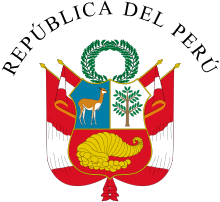 |
|---|
| This article is part of a series on the politics and government of Peru |
| Constitution |
|
|
|
|
Autonomies
|
|
|
|
|
|
|
The historian Antonio Zapata describes Peru as a "right-wing country", the only left-wing government in contemporary history being that of Juan Velasco Alvarado (1968-1975), author of agrarian reform and the nationalization of strategic sectors. Currently, almost all major media and political parties are in favour of economic liberalism.[4]
History
In 1924, from Mexico, university reform leaders in Peru who had been forced into exile by the government founded the American People's Revolutionary Alliance, which had a major influence on the country's political life. APRA is thus largely a political expression of the university reform and workers' struggles of the years 1918-1920. The movement draws its influences from the Mexican revolution and its 1917 Constitution, particularly on issues of agrarianism and indigenism, and to a lesser extent from the Russian revolution. Close to Marxism (its leader, Haya de la Torre, declares that "APRA is the Marxist interpretation of the American reality"), it nevertheless moves away from it on the question of class struggle and on the importance given to the struggle for the political unity of Latin America.[5]
In 1928, the Peruvian Socialist Party was founded, notably under the leadership of José Carlos Mariátegui, himself an spectator of the European socialist movements, who maintained relantionships with the Communist Party of Italy and the leadership of Palmiro Togliatti and Antonio Gramsci. Shortly afterwards, in 1929, the party created the General Confederation of Workers.
Democratic reform
The Republic of Peru is in a state of ongoing democratization. Led by President Martin Vizcarra, the new government is expected to be transparent and accountable.[6] Previously a rubberstamp body, Peru's unicameral Congress is emerging as a strong counterbalance to the once-dominant executive branch, with increased oversight and investigative powers. The executive branch and Congress are attempting to reform the judicial branch, antiquated and rife with corruption.
During the government of Fujimori the 1979 Constitution was changed after the Fujimori's self-coup where the president dissolved the Congress and established the new 1993 Constitution. One of the changes to the 1979 Constitution was the possibility of the president's immediate reelection (112 article) which made possible the reelection of Fujimori in the next years. After the Fujimori era and Fujimori's resignation, the transition government of Valentín Paniagua changed the article 112 and called new elections in 2001 where Alejandro Toledo was elected. After that, Peru has had all presidents democratically elected.
Executive branch
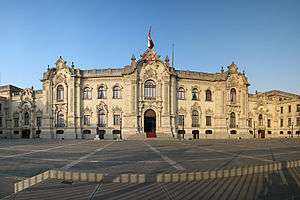
| Office | Name | Party | Since |
|---|---|---|---|
| President | Martín Vizcarra | Independent | 23 March 2018 |
| First Vice President | Vacant | 1 October 2019 | |
| Second Vice President | Vacant | 23 March 2018 | |
| Prime Minister | Vicente Zeballos | Independent | 30 September 2019 |
Under the current constitution, the President is the head of state and government; he or she is elected for a five-year term and may not immediately be re-elected.[7] All citizens above the age of eighteen are entitled and in fact compelled to vote. The first and second vice presidents also are popularly elected but have no constitutional functions unless the president is unable to discharge his duties.
The President appoints the Prime Minister (Primer Ministro) and the Council of Ministers (Consejo de Ministros, or Cabinet), which is individually and collectively responsible both to the president and the legislature.[1][2] All presidential decree laws or draft bills sent to Congress must be approved by the Council of Ministers.
Legislative branch
The legislative branch consists of a unicameral Congress (Congreso) of 130 members. elected for a five-year term by proportional representation In addition to passing laws, Congress ratifies treaties, authorizes government loans, and approves the government budget. The president has the power to block legislation with which the executive branch does not agree.
Political parties and elections
Presidential election
The first round was held on 10 April. Exit polls indicated that Keiko Fujimori placed first in the first round of voting with approximately 40% of the vote, with Pedro Pablo Kuczynski and Veronika Mendoza each receiving approximately 20%.[8]
The second round was held on 5 June. Exit polls indicated that Pedro Pablo Kuczynski held a slight lead over Keiko Fujimori. As counting continued, the gap narrowed significantly. Preliminary results gave Kuczynski a 0.25 per cent advantage over Fujimori, with less than 50,000 votes between them. Approximately 50,000 votes were challenged during the count.[9] Fujimori conceded the election to Kuczynski on 10 June.[10]
| Candidate | Party | First round | Second round | |||
|---|---|---|---|---|---|---|
| Votes | % | Votes | % | |||
| Keiko Fujimori | Popular Force | 6,115,073 | 39.86 | 8,555,880 | 49.88 | |
| Pedro Pablo Kuczynski | Peruvians for Change | 3,228,661 | 21.05 | 8,596,937 | 50.12 | |
| Verónika Mendoza | Broad Front | 2,874,940 | 18.74 | |||
| Alfredo Barnechea | Popular Action | 1,069,360 | 6.97 | |||
| Alan García | Popular Alliance | 894,278 | 5.83 | |||
| Gregorio Santos | Direct Democracy | 613,173 | 4.00 | |||
| Fernando Olivera | Hope Front | 203,103 | 1.32 | |||
| Alejandro Toledo | Possible Peru | 200,012 | 1.30 | |||
| Miguel Hilario | Developing Peru | 75,870 | 0.49 | |||
| Antero Flores Aráoz | Order Party | 65,673 | 0.43 | |||
| Invalid/blank votes | 3,393,987 | – | 1,190,079 | – | ||
| Total | 18,734,130 | 100 | 18,342,896 | 100 | ||
| Registered voters/turnout | 22,901,954 | 81.80 | 22,901,954 | 80.09 | ||
| Source: ONPE, ONPE | ||||||
Parliamentary elections
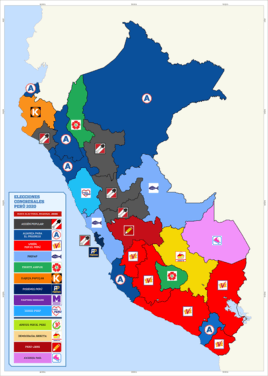
The election was the most divided in Peruvian history, with no party receiving more than 11% of the vote. The Fujimorist Popular Force, the largest party in the previous legislature, lost most of its seats, and the American Popular Revolutionary Alliance (APRA) had its worst ever election result, failing to win a seat for the first time since before the 1963 elections. New or previously minor parties such as Podemos Perú, the Purple Party and the Agricultural People's Front had good results. Contigo, the successor to former president Pedro Pablo Kuczynski's Peruvians for Change party, failed to win a seat and received only around 1% of the vote. The result was seen as representative of public support for president Martín Vizcarra's anti-corruption reform proposals.
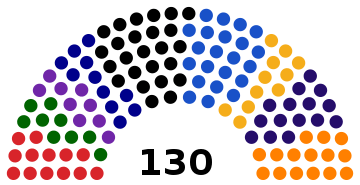 | ||||||||
| Party | Votes | % | Seats | +/– | ||||
|---|---|---|---|---|---|---|---|---|
| Popular Action | 1,518,171 | 10.26 | 25 | +20 | ||||
| Podemos Perú | 1,240,716 | 8.38 | 11 | New | ||||
| Agricultural People's Front | 1,240,084 | 8.38 | 15 | New | ||||
| Alliance for Progress | 1,178,020 | 7.96 | 22 | [lower-alpha 1] | ||||
| Purple Party | 1,095,491 | 7.40 | 9 | New | ||||
| Popular Force | 1,081,174 | 7.31 | 15 | –58 | ||||
| Union for Peru | 1,001,716 | 6.77 | 13 | New | ||||
| Broad Front | 911,701 | 6.16 | 9 | –11 | ||||
| We Are Peru | 895,700 | 6.05 | 11 | [lower-alpha 1] | ||||
| Together for Peru | 710,462 | 4.80 | 0 | New | ||||
| Christian People's Party | 590,378 | 3.99 | 0 | 0 | ||||
| Direct Democracy | 543,956 | 3.68 | 0 | 0 | ||||
| Perú Libre | 502,898 | 3.40 | 0 | New | ||||
| APRA | 402,330 | 2.72 | 0 | –5 | ||||
| Go on Country | 373,113 | 2.52 | 0 | New | ||||
| Perú Patria Segura | 350,121 | 2.37 | 0 | New | ||||
| Go Peru | 311,413 | 2.10 | 0 | New | ||||
| National United Renaissance | 265,564 | 1.79 | 0 | New | ||||
| National Solidarity Party | 221,123 | 1.49 | 0 | New | ||||
| Peru Nation | 206,128 | 1.39 | 0 | New | ||||
| Contigo | 158,120 | 1.07 | 0 | New | ||||
| Invalid/blank votes | 3,570,709 | – | – | – | ||||
| Total | 18,369,088 | 100 | 130 | 0 | ||||
| Registered voters/turnout | 24,812,087 | 74.07 | – | – | ||||
| Source: ONPE | ||||||||
Judicial branch
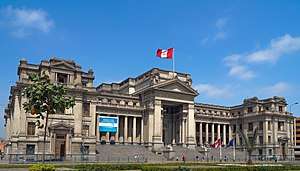
The judicial branch of government is headed by a 16-member Supreme Court seated in Lima. The National Council of the Judiciary appoints judges to this court.
The Constitutional Court (Tribunal Constitucional) interprets the constitution on matters of individual rights. Superior courts in regional capitals review appeals from decisions by lower courts. Courts of first instance are located in provincial capitals and are divided into civil, penal, and special chambers. The judiciary has created several temporary specialized courts in an attempt to reduce the large backlog of cases pending final court action.
Peru's legal system is based on civil law system. Peru has not accepted compulsory ICJ jurisdiction. In 1996 a human rights ombudsman's office (defensor del pueblo) was created to address human rights issues.
Administrative divisions
Peru's territory, according to the Regionalization Law which was passed on 18 November 2002, is divided into 25 regions (regiones). These regions are subdivided into provinces, which are composed of districts. There are a total of 180 provinces and 1747 districts in Peru.
Lima Province is not part of any political region.
- Amazonas
- Ancash
- Apurímac
- Arequipa
- Ayacucho
- Cajamarca
- Callao
- Cusco
- Huancavelica
- Huánuco
- Ica
- Junín
- La Libertad
- Lambayeque
- Lima Provincias
- Loreto
- Madre de Dios
- Moquegua
- Pasco
- Piura
- Puno
- San Martín
- Tacna
- Tumbes
- Ucayali
Political pressure groups and leaders
Leftist guerrilla groups include Shining Path Abimael Guzmán (imprisoned), Gabriel Macario (top leader at-large); Túpac Amaru Revolutionary Movement or MRTA Victor Polay (imprisoned), Hugo Avellaneda Valdez (top leader at-large). Both Shining Path & MRTA are considered terrorist organizations.
Non-governmental organizations
In the early 1970s and 1980s many grass-roots organizations emerged in Peru. They were concerned with problems of local people and poverty reduction. After 2000 they played an important role in the decentralisation process. Their hope was that power would be divided clearly between national and local governments and the latter would be able to address social justice and the concerns of local people better than the national government could. Some NGO-members even became part of local governments. There is debate extent to which this engagement in politics contributes to the attainment of their original goals.[11]
International organization participation
Peru or Peruvian organizations participate in the following international organizations:
- Asia-Pacific Economic Cooperation (APEC)
- Andean Community of Nations (CAN)
- Food and Agriculture Organization (FAO)
- Group of Fifteen (G-15)
- Group of Twenty-Four (G-24)
- Group of 77 (G-77)
- Inter-American Development Bank (IADB)
- International Atomic Energy Agency (IAEA)
- International Bank for Reconstruction and Development (IBRD, part of the World Bank Group)
- International Civil Aviation Organization (ICAO)
- International Criminal Court (ICC)
- International Chamber of Commerce (ICC)
- International Confederation of Free Trade Unions (ICFTU)
- International Red Cross
- International Development Association (IDA)
- International Fund for Agricultural Development (IFAD)
- International Finance Corporation (IFC)
- International Federation of Red Cross and Red Crescent Societies (IFRCS)
- International Hydrographic Organization (IHO)
- International Labour Organization (ILO)
- International Monetary Fund, (IMF)
- International Maritime Organization (IMO)
- Interpol
- IOC
- International Organization for Migration (IOM)
- International Organization for Standardization (ISO) (correspondent)
- International Telecommunication Union (ITU)
- Latin American Economic System (LAES)
- Latin American Integration Association (LAIA)
- United Nations Organization Mission in the Democratic Republic of the Congo (MONUC)
- Non-Aligned Movement (NAM)
- OAS
- Agency for the Prohibition of Nuclear Weapons in Latin America and the Caribbean (OPANAL)
- Organisation for the Prohibition of Chemical Weapons (OPCW)
- Permanent Court of Arbitration (PCA)
- Rio Group (RG)
- Union of South American Nations(Unasul-Unasur)
- United Nations
- United Nations Conference on Trade and Development (UNCTAD)
- United Nations Educational, Scientific, and Cultural Organization (UNESCO)
- UNHRC United Nations Human Rights Council (UNHRC)
- United Nations Industrial Development Organization (UNIDO)
- United Nations Mission in Ethiopia and Eritrea (UNMEE)
- United Nations Mission in Liberia (UNMIL)
- Universal Postal Union (UPU)
- World Confederation of Labour (WCL)
- World Customs Organization (WCO)
- World Federation of Trade Unions (WFTU)
- World Health Organization (WHO)
- World Intellectual Property Organization (WIPO)
- World Meteorological Organization (WMO)
- World Tourism Organization (WToO)
- World Trade Organization (WTrO)
See also
Notes
- Part of the Alliance for the Progress of Peru coalition in the 2016 general election
References
- Shugart, Matthew Søberg (September 2005). "Semi-Presidential Systems: Dual Executive and Mixed Authority Patterns" (PDF). Graduate School of International Relations and Pacific Studies. Archived from the original (PDF) on 19 August 2008. Retrieved 31 August 2017.CS1 maint: ref=harv (link)
- Shugart, Matthew Søberg (December 2005). "Semi-Presidential Systems: Dual Executive And Mixed Authority Patterns" (PDF). French Politics. 3 (3): 323–351. doi:10.1057/palgrave.fp.8200087. ISSN 1476-3427. OCLC 6895745903. Retrieved 31 August 2017.
Only in Latin America have all new democracies retained a pure presidential form, except for Peru (president-parliamentary) and Bolivia (assembly-independent).
CS1 maint: ref=harv (link) - The Economist Intelligence Unit (8 January 2019). "Democracy Index 2019". Economist Intelligence Unit. Retrieved 13 January 2019.
- http://www.medelu.org/Peru-la-derecha-o-la-derecha
- Latin America in the 20th century: 1889-1929, 1991, p. 314-319
- "Peru's president doesn't haveroom for failure". miamiherald.com.
- Constitución Política del Perú, Article No. 112.
- "Peru election: Keiko Fujimori wins first round, say exit polls – BBC News". BBC News. Retrieved 2016-04-11.
- "Peru election: Kuczynski wins, but Fujimori has yet to concede". BBC News. Retrieved 11 June 2016.
- "Peru elections: Keiko Fujimori concedes to Kuczynski". BBC News. Retrieved 11 June 2016.
- Monika Huber, Wolfgang Kaiser (February 2013). "Mixed Feelings". dandc.eu.
External links
| Wikimedia Commons has media related to Politics of Peru. |

.svg.png)